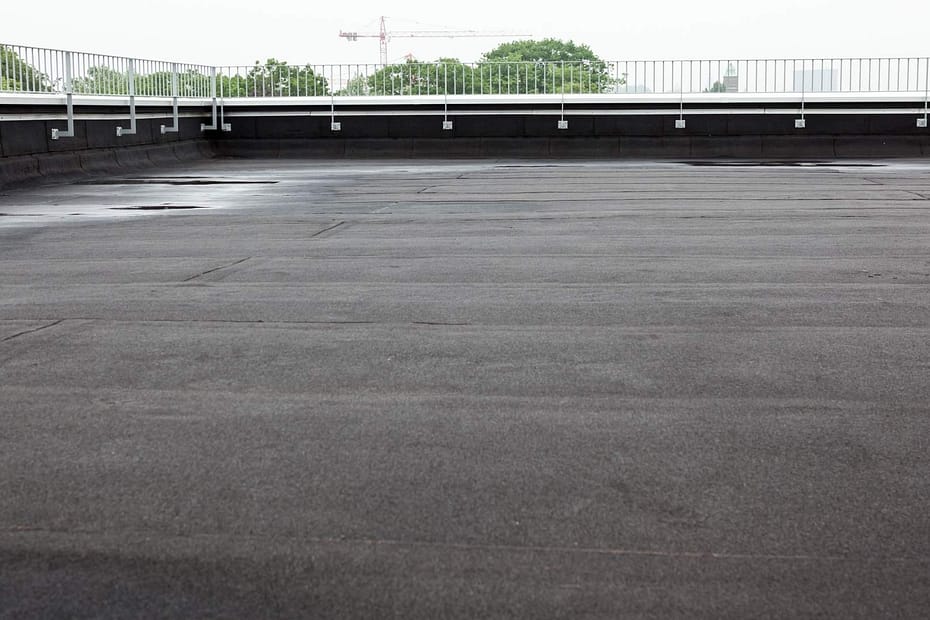A flat roof is a roof type that is characterized by a very slight pitch or an absence of inclination. This type of roof, which is more frequently found in commercial buildings, has also, in recent years, been gaining more and more favor in use among residential houses. That’s because it goes very well with that modern style that has become so popular. There are various materials for flat roof construction, but the most commonly used material is rubber roofing which is EPDM and is very durable. But the glaring question with any roof of this type is that of flat roof drainage.
In this type of structure, since water and debris cannot simply slide down the top as would be the case in a traditionally sloped top, what becomes of the water and debris that are not supposed to lie on your roof? We will address flat roof drainage solutions that you can consider if you want to install a flat roof in your home below.

Pros and Cons of a Flat Roof
By normal roof standards, it is normal to find flat roof options that are favorable and those that are not in case you want to install a flat roof in your home. And here are some of them.
Pros of a flat roof
- Easy accessibility. Since it is not very difficult to get to the roof and walk on it because the slope of consideration is quite minimal, this increases the ease of performing repairs and carrying out maintenance operations compared to the higher sloped roofs.
- Cost Effective. This is one of the less costly types of roofing, and if properly installed with great-quality materials, it enjoys a very long lifespan as well. Because roofing contractors don’t have to struggle that much getting to the roof and performing their work, you might enjoy lower expenses for repairs and maintenance as well. Furthermore, the cost of EPDM roofing material is lower than other roofing materials such as clay, slate, metal and asphalt.
- Provides storage. A flat roof is a convenient - and aesthetically pleasing - place to store solar panels and satellite dishes.
Cons of a flat roof
The biggest drawback of a flat roof? Drainage, of course! Since there’s little to no pitch, a flat roof does require a bit of routine maintenance to ensure water is properly draining from it. With that in mind, we’ll take a look at some popular types of flat roof drainage.

Types of Flat Roof Drainage
All four of these types of flat roof drainage are different, but each functions well at its job of removing excess moisture from a flat roof: something that’s an ongoing challenge.
Internal drain
Still another excellent option that falls into the category of flat roof drainage is this type of flat roof drainage since it does not in any way interfere with the appearance of the home from outside. Several drains are placed on the roof and connected in a pipe that runs vertically on the wall within the structure like a house drainage system.These pipes lead rainwater away from the home. Each drain on the roof is equipped with a mesh screen or filter to prevent debris from entering the pipes.
Siphonic drain
This bizarre word describes a drain that uses gravity to run a vacuum that pulls water into the drain, rather than simply operating as a passive drain. Far more effective at removing water from a flat roof than a regular drain, siphonic drains are best for climates that see a lot of rain, such as the Pacific Northwest or even rainforest regions. A siphonic drain is a much more complicated system than a regular drain, requiring a roofing professional who has experience installing these, and often having to be calibrated for the exact annual rainfall amount in the area.
Scupper
This funny term simply refers to a cutout in the side of the home that allows water to drain off of a flat roof. Scuppers were originally used on wooden ships to drain water from the boat’s deck. Scuppers can be an effective flat roof drainage system, but they do require some sort of pitch in order to direct water into them.
Traditional gutters
If your flat roof has any pitch at all to it, you can still use a traditional gutter system to drain water from it. That’s because a slightly pitched “flat” roof will tend to be pitched in a single direction, at the end of which a gutter can effectively remove most moisture from the roof. It’s important to note that gutters can be used on a flat roof either alone or along with a secondary type of flat roof drainage system.
Any work you need done on your flat roof should be performed by a qualified roofing professional if you’re not interested in attempting a DIY roofing project. Even installing a drain system on a flat roof can be quite challenging for a first timer. Think you might be facing a replacement of your home’s flat roof? Consult this handy flat roof replacement cost calculator to get an idea of what you might need to spend.
Fact Checked By Christin Perry 10/4/2024

